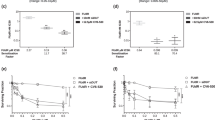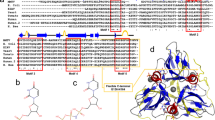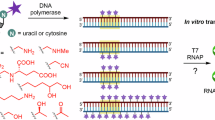Abstract
Thymidylate synthase (TS) is an important enzyme catalysing the reductive methylation of dUMP to dTMP that is further metabolized to dTTP for DNA synthesis. Loss of viability following TS inhibition occurs as a consequence of depleted dTTP pools and at least in some cell lines, accumulation of dUTP and subsequent misincorporation of uracil into DNA. The expansion in dUTP pools is largely determined by the expression of the pyrophosphatase, dUTPase. Our previous work has shown that following TS inhibition the ability to accumulate dUTP was associated with an earlier growth inhibitory effect. 3 human lung tumour cell lines and HT29 human colon tumour cells transfected with dUTPase have been used to investigate the relationship between loss of viability following TS inhibition and dUTP accumulation. Cell cycle arrest typical of TS inhibition was an early event in all cell lines and occurred irrespective of the ability to accumulate dUTP or p53 function. However, a large expansion of dUTP pools was associated with mature DNA damage (4 h) and an earlier loss of viability following TS inhibition compared to cells in which dUTP pools were not expanded. In A549 cells damage to mature DNA may have been exacerbated by significantly higher activity of the excision repair enzyme, uracil-DNA glycosylase. Consistent with results using different inhibitors of TS, transfection of dUTPase into HT29 cells significantly reduced the cytotoxicity of a 24 h but not 48 h exposure to ZD9331. Although loss of viability can be mediated through dTTP deprivation alone, the uracil misincorporation pathway resulted in an earlier commitment to cell death. The relevance of this latter pathway in the clinical response to TS inhibitors deserves further investigation. © 2001 Cancer Research Campaign
Similar content being viewed by others
Article PDF
Change history
16 November 2011
This paper was modified 12 months after initial publication to switch to Creative Commons licence terms, as noted at publication
References
Aherne GW, Hardcastle A, Raynaud F and Jackman AL (1996) Immunoreactive dUMP and TTP pools as an index of thymidylate synthase inhibition; Effect of Tomudex (ZD1694) and a nonpolyglutamated quinazoline antifolate (CB30900) in L1210 mouse leukaemia cells. Biochem Pharmacol 51: 1293–1301
Aherne GW and Brown SD (1999) The role of uracil misincorporation in thymineless death. Anticancer Drug Development Guide: Antifolate Drugs in Cancer Therapy, AL Jackman (ed) Humana Press Inc.: Totowa, NJ 409–421
Arrendondo MA, Yin MB, Lu K, Schoeber C, Slocum HK and Rustum YM (1994) Decreased c-myc protein accompanied by increased p53 and Rb is associated with thymidylate synthase inhibition and cell cycle retardation induced by ZD1694. Proc Am Assoc Cancer Res 35: 304
Brown SD, Hardcastle A and Aherne GW (1997) Deoxyuridine triphosphatase (dUTPase) expression and cellular response to TS inhibitors. Chemistry and Biology of Pteridines and Folates, Pfleider W, Rokos H (eds) pp. 271–274 Blackwell Science: Berlin
Brynolf K, Eliasson R and Reichard P (1978) Formation of Okazaki fragments in polyoma DNA synthesis caused by misincorporation of uracil. Cell 13: 573–580
Canman CE, Lawrence TS, Shewach DS, Tang HY and Maybaum J (1993) Resistance to fluorodeoxyuridine induced DNA damage and cytotoxicity correlates with an elevation of deoxyuridine triphosphatase activity and failure to accumulate deoxyuridine triphosphate. Cancer Res 53: 1–6
Canman CE, Radany EH, Parsels LA, Davis MA, Lawrence TS and Maybaum J (1994) Induction of resistance to fluorodeoxyuridine cytotoxicity and DNA damage in human tumour cells by expression of Escherichia-coli deoxyuridine triphosphatase. Cancer Res 54: 2296–2298
Caradonna SJ and Cheng Y (1980) Uracil DNA-glycosylase: purification and properties of this enzyme isolated from blast cells of acute myelocytic leukemia patients. J Biol Chem 255: 2293–2300
Chong L and Tattersall MHN (1995) 5, 10 Dideazatetrahydrofolic acid reduces toxicity and deoyadenosine triphosphate pool expansion in cultural L1210 cells treated with inhibitors of thymidylate synthase. Biochem Pharmacol 49: 819–827
Curtin NJ, Harris AL and Aherne GW (1991) Mechanisms of cell death following thymidylate synthase inhibition: 2 deoxyuridine 5 triphosphate accumulation, DNA damage, and growth inhibition following exposure to CB3717 and dipyridamole. Cancer Res 51: 2346–2352
Darzynkiewicz Z, Bruno S, Del Bino G, Gorczyca W, Hotz MA, Lassota P and Traganos F (1992) Features of apoptotic cells measured by flow cytometry. Cytometry 13: 795–808
Fisher TC, Milner AE, Gregory CD, Jackman AL, Aherne GW, Hartley JA, Dive C and Hickman J (1993) Bcl-2 modulation of apoptosis induced by anticancer drugs-resistance to thymidylate stress is independent of classical resistance pathways. Cancer Res 53: 3321–3326
Goulian M, Bleile BM, Dickey LM, Grafstrom RH, Ingraham HA, Neynaben SA, Peterson MS and Tseng BY (1986) Mechanism of thymineless death. Adv Exp Med Biol 195: 89–95
Hartwell L and Kastan MB (1994) Cell cycle control and cancer. Science (Washington DC) 266: 1821–1828
Houghton JA, Harwood FG and Houghton PS (1994) Cell cycle control processes determine cytostasis or cytotoxicity in thymineless death of colon cancer cells. Cancer Res 54: 4967–4973
Houghton JA, Tilman DM and Harwood FG (1995) Ratio of 2′-deoxyadenosine-5′-triphosphate/ thymidine-5′-triphosphate influences the commitment of human colon carcinoma cells to thymineless death. Clin Cancer Res 1: 723–730
Jackman AL and Judson IR (1996) The new generation of thymidylate synthase inhibitors in clinical study. Exp Opin Invest Drugs 5: 719–736
Jackman AL, Kimbell R, Aherne GW, Brunton L, Jansen G, Stephens TC, Smith MC, Wardleworth JM and Boyle FT (1997) Cellular pharmacology and invivo activity of a new anticancer agent ZD9331: A water-soluble, nonpolyglutamatable, quinazoline inhibitor of thymidylate synthase. Clin Cancer Res 3: 911–921
Jackson RC, Jackman AL and Calvert AH (1983) Biochemical effects of quinazoline inhibitor of thymidylate synthase CB3717 on human lymphoblastoid cells. Biochem Pharmocol 33: 3783–3790
Kohn KW (1981) Principles and practice of DNA filter elution. Pharmac Ther 49: 55–77
Ladner R and Caradonna S (1997) Lowering dUTPase levels through antisense induces sensitivity to fluorodeoxyuridine in HT29 cells. Proc Am Assoc Cancer Res 38: 614
Matsui S, Arredondo MA, Wrzosek C and Rustum YM (1996) DNA damage and p53 induction do not cause ZD1694-induced cell cycle arrest in human colon carcinoma cells. Cancer Res 56: 4715–1723
Muller-Weeks S and Caradonna S (1996) Specific association of cyclin like uracil-DNA glycosylase with the proliferating cell nuclear antigen. Exp Cell Res 226: 346–355
Nelson WG and Kastan MB (1994) DNA strand breaks: the DNA template alterations that trigger p53-dependent DNA damage response pathways. Mol Cell Biol 14: 1815–1823
O'Connor PM (1987) Mammalian G1 and G2 phase checkpoints. Cancer Surv 29: 151–182
Parsels LA, Parsels JD, Wagner LM, Loney TL, Radany EH and Maybaum J (1998) Mechanism and pharmacological specificity of dUTPase-mediated protection from DNA damage and cytotoxicity in human tumor cells. Cancer Chemother Pharmacol 42: 357–362
Savage JRK and Prasad R (1988) Generalized blocking in S phase by methotrexate. Mut Res 201: 195–201
Skelton LA, Ormerod MG, Titley JC and Jackman AL (1998) Cell cycle effects of CB30865, a lipophilic quinazoline-based analogue ICI 198583 with an undefined mechanism of action. Cytometry 33: 56–66
Sundseth R, Singer S, Yates B, Smith G, Ferone R and Dev I (1997) Thymineless apoptotic death induced by 1843U89 in human tumour cell lines is independent of dUTP accumulation and misincorporation of dUMP into DNA. Proc Am Assoc Cancer Res 38: 476
Tang HY, Weber KL, Lawrence TS, Merchant AK and Maybaum J (1996) Dependence of fluorodeoxyuridine-induced cytotoxicity and megabase DNA fragmentation on S phase progression in HT29 cells. Cancer Chemother Pharmacol 37: 486–490
Taylor IW, Slowiaczek P, Francis PR and Tattersall MHN (1982) Purine modulation of methotrexate cytotoxicity in mammalian cell lines. Cancer Res 42: 5159–5164
Tonkinson JL, Marder P, Andis SL, Schultz RM, Gossett LS, Shih C and Mendelsohn LG (1997) Cell cycle effects of antifolate antimetabolites: implications for cytotoxicity and cytotasis. Cancer Chemother Pharmacol 39: 521–531
Webley SD, Hardcastle A, Ladner RD, Jackman AL and Aherne GW (2000) Deoxyuridine triphosphate (dUTPase) expression and sensitivity to the thymidylate synthase (TS) inhibitor ZD9331. Br J Cancer 83: 792–799
Yin MB, Guimalaes MA, Zhang Z, Arrendondo MA and Rustum YM (1992) Time dependence of DNA lesions and growth inhibition by ICI D1694, a new quinazoline antifolate thymidylate synthase inhibitor. Cancer Res 52: 5900–5905
Zambetti GP and Levine AJ (1993) A comparison of the biological activities of wild type and mutant p53. FASEB J 7: 855–865
Author information
Authors and Affiliations
Rights and permissions
From twelve months after its original publication, this work is licensed under the Creative Commons Attribution-NonCommercial-Share Alike 3.0 Unported License. To view a copy of this license, visit http://creativecommons.org/licenses/by-nc-sa/3.0/
About this article
Cite this article
Webley, S., Welsh, S., Jackman, A. et al. The ability to accumulate deoxyuridine triphosphate and cellular response to thymidylate synthase (TS) inhibition. Br J Cancer 85, 446–452 (2001). https://doi.org/10.1054/bjoc.2001.1921
Received:
Revised:
Accepted:
Published:
Issue date:
DOI: https://doi.org/10.1054/bjoc.2001.1921
Keywords
This article is cited by
-
Discovery of two new isoforms of the human DUT gene
Scientific Reports (2023)
-
Metabolic basis of neuronal vulnerability to ischemia; an in vivo untargeted metabolomics approach
Scientific Reports (2020)
-
Structural model of human dUTPase in complex with a novel proteinaceous inhibitor
Scientific Reports (2018)
-
Standing the test of time: targeting thymidylate biosynthesis in cancer therapy
Nature Reviews Clinical Oncology (2014)
-
Mechanism of trifluorothymidine potentiation of oxaliplatin-induced cytotoxicity to colorectal cancer cells
British Journal of Cancer (2007)



